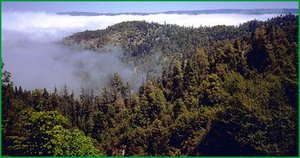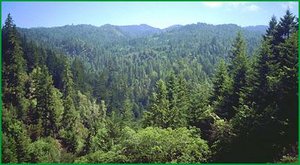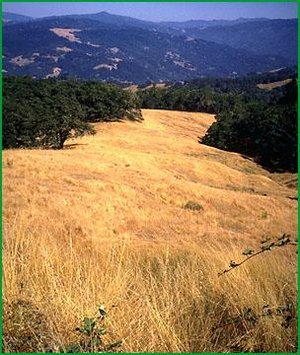Central Franciscan (Bailey)
This subsection is a steep mountainous area of the northern California Coast Ranges, south-southeast of Patricks Point. Most of it is between the Bald Mountain fault on the east-northeast and the Fresh Water fault on the west-southwest. The climate is temperate and humid. There is substantial oceanic influence on climate, including summer fog in the northern part of the subsection. MLRAs 4b and 5b.
Contents
Lithology and Stratigraphy
This subsection is dominated by Jurassic and Cretaceous Franciscan sedimentary, minor volcanic, and metamorphic rocks of the Central Belt; some Franciscan rocks of the Coastal Belt are present. They are intensely folded and faulted. There are small areas of Tertiary marine sedimentary rocks and ultramafic rocks are sparsely scattered through the Franciscan Complex.
Geomorphology
This is a subsection of mountains with rounded ridges, steep and moderately steep sides, and narrow canyons. Most of the mountains are elongated in north-northwest to northwest directions and have subequal summits with increasing elevation toward the interior. Larabee Valley along the Van Duzen River is wide enough to have an appreciable alluvial plain. The subsection elevation range is from sea-level up to 4408 feet on Showers Mountain. Mass wasting and fluvial erosion are the main geomorphic processes.
Soils
The soils are mostly Typic Humitropepts and Mollic Hapudalfs in the northern one-third of the subsection. They are predominantly Dystric Xerochrepts and Haploxeralfs in the southern two-thirds of the subsection, and less extensive Ultic Argixerolls. The soils are leached free of carbonates, with the possible exception of some Argixerolls, and the older ones in the northern part of the subsection are strongly acid. The soil temperature regimes are predominantly isomesic in the northern one-third and mesic in the southern two-thirds of the subsection. Soils in grassland in the southern part of the subsection have thermic soil temperature regimes. Soil moisture regimes are predominantly udic and xeric (near udic).
Vegetation
The predominant natural plant communities are Redwood series in the northern one-third and Douglas-fir - tanoak series in the southern two-thirds of the subsection. Needlegrass grasslands are common in the southern part of the subsection, and Oregon white oak series is also common. Common in riparian areas are Red alder series in the northern part and Black cottonwood series in the southern part of the subsection.
Characteristic series by lifeform include:
- Grasslands: Introduced perennial grassland series, Purple needlegrass series.
- Shrublands: Coyote brush series, Salal - California huckleberry series.
- Forests and woodlands: Black cottonwood series, Black oak series, California bay series, Douglas-fir—tanoak series, Grand fir series, Oregon white oak series, Redwood series, Sitka spruce series, Tanoak series, Western hemlock series.
Climate
The mean annual precipitation is about 40 to 80 inches. Most is rain at lower elevations and some is snow at higher elevations. Mean annual temperature is about 40° to 53°F. The mean freeze-free period is about 225 to 300 days.
Surface Water
Runoff is rapid and many of the smaller streams are dry by the end of the summer. Natural lakes are absent.
Return to Northern California Coast


